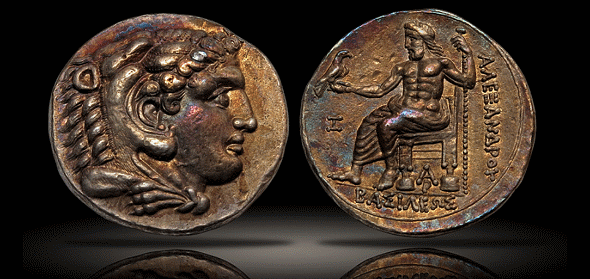By Russell A. Augustin, AU Capital Management, LLC …… Source: coinweek.com
The early Macedonian kingdom did not have sufficient access to mines to be able to mass-produce influential coinage. However, when Philip II rose to power in 359 BCE, he recognized the importance of mining and prioritized the acquisition of metals in his early conquests.
After defeating Amphipolis and Crenides, Philip was able to secure a consistent annual supply of nearly 30 metric tonnes of precious metal, striking them into new, iconic coinage. This production volume made Philip’s coins immensely popular throughout the world.
His son, Alexander the Great, continued Philip’s coinage and improved upon it, refocusing the silver mintage on a tetradrachm based on the Athenian weight standard that could be used easily throughout Greece. For more than two hundred years, Alexander the Great Tetradrachms would be minted at a prolific rate, sourced from his father’s mines in Thrace and Macedonia as well as the new bullion Alexander received when he conquered the Persians.
A single coin represented approximately four day’s pay for a common laborer, so Alexander also minted bronze coinage for small transactions in local markets. However, Alexander the Great Tetradrachms were the most famous of his denominations, becoming one of the staple coins of the Greek world through their use in substantial purchases, international trade, and for mercenary payments.
This Alexander the Great Tetradrachm coin is among the types struck during Alexander’s lifetime, which are the considered to be the most artistic. Although the style of these coins would change significantly depending on when and where they were minted, the primary design elements would remain very consistent.
The obverse depicts Herakles (or Hercules to the Romans), the greatest hero of the Greeks. Herakles was Zeus’ son and was able to attain divine status as a demi-god by accomplishing the 12 Labors assigned to him. This coin represents the first of those labors, the slaying of the fierce Nemean Lion.
Herakles is shown proudly wearing the lion’s skin, its open mouth covering most of his head and its paws tied together at his neck. Alexander the Great idolized Herakles, wanting to become a god himself, and his prominent use of the hero on his coins formalized this association, evangelizing it internationally.
The reverse shows Zeus wearing a crown, likely a laurel wreath, atop his long hair. Zeus’ body changes depending on the coin, but this example shows him as very muscular, wearing a linen cloak (a himation) covering his lower body.
He is seated on a decorated throne, holding a scepter which symbolizes the god’s strength and authority, and consequently, that of Alexander as well. This coin also shows him holding his symbolic bird, an eagle, in his outstretched right hand.
The reverse inscription on this coin reads “ΒΑΣΙΛΕΩΣ ΑΛΕΞΑΝΔΡΟΥ” which translates to “Of King Alexander”. It is speculated that Alexander chose a unique and detailed reverse depiction of Zeus (which would appeal to his current and future subjects) rather than base it off of a well-known statue (which could potentially alienate some groups based on their specific religious associations). This foresight likely played a role in the ongoing popularity and universal acceptance of his tetradrachm coinage.
MACEDONIAN KINGDOM. Alexander III the Great (336-323 BCE). AR tetradrachm (17.14 gm). Aradus, late lifetime issue, ca. 324/3 BCE. Head of Heracles right, wearing lion-skin headdress / Zeus seated left, holding eagle and scepter; I in left field; AP monogram below throne. Price 3325. Well-centered on a broad flan with superb eye appeal. Good Extremely Fine.
Source: coinweek.com









